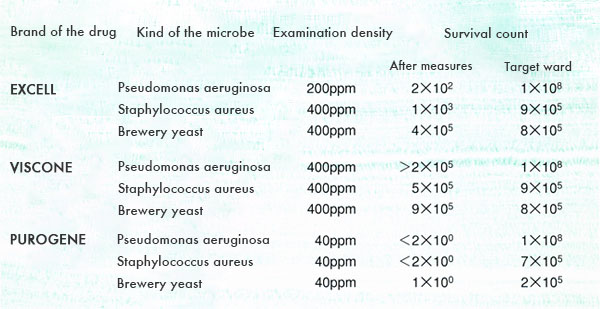- Top>
- Company Profile>
- New Materials and Ingredients>
- Aquatic chlorine dioxide>
- Material data
New Materials and Ingredients
|New Materials and Ingredients|Scallop husks calcination calcium|Aquatic chlorine dioxide|
Aquatic chlorine dioxide
|Aquatic chlorine dioxide|Secondary product|Technical information|Material data|
Material data
Comparison with the sterilizing agent of other chlorine dioxide bases
In the U.S., the comparative study of the sterilizing agent of three kinds of chlorine dioxide bases was performed for "staphylococcus aureus", the "pseudomonas aeruginosa", and "beer yeast." The sterilizing agent of the chlorine dioxide base of the comparative test was examined after being activated by each optimal method.
EXCELL:With acetic acid, the pH to 4.0 is adjusted and it was activated, and before diluting to operating concentration, it was left at rest for 15 minutes.
VISCONE:1g active agent"K" of the product 1.51L per company's recommendation was added, and it was activated, and before diluting to operating concentration, it left at rest for 15 minutes.
PUROGENE:Add 1g of crystal citric acid per 0.098L, and it is activated, and leave at rest for 5 minutes before diluting to operating concentration.
PUROGENE is a proprietary name of the chlorine dioxide agent which our company develops and uses.

Sterilization to a typical food poisoning bacillus
Vibrio parahaemolyticus,(1FO 12711)
The cultivated vibrio parahemolytica was taken in to the nutrient agar medium of NaCl addition 3%, and at 35 ℃, the mycelia cake was made to float in 3% of fungus liquid NaCl liquid after cultivation overnight, and it was examined after adjusting the number of bacilli per 1mL to 108 (CFU). (Japan Food Research Laboratories) The Examination solution of 3,200 ppm concentration was used and examination solution was diluted with sterile purified water.

Campylobacter jejuni
After carrying out aerobic cultivation of the 42 ℃ for 72 hours using a strange method peculiar culture medium, Campylobacter adjusted to 108 (CFU/ml) with the phosphate buffered saline is put in a test tube by 5mL, Test solution 0.1mL which was diluted with distilled water and made into 50 ppm concentration after adding 1 g of citrate to this to "PUROGENE" 10mL was added, and it collected 0.1 mL at a time 1, 3, 5, and 15 minutes afterward, and applied to the strange method peculiar culture medium, and fine aerobic cultivation was carried out for 72 hours, and 42 ℃ of the numbers of survival bacilli were measured. (Food and Drug Safety Center Hadano research institute)
Escherichia coli O-157:H7
E. coli bacillus O-157:H7 usually beforehand cultivated with bouillon is diluted to 104 CFU/mL per 1mL, One mL each addition was carried out into solution 10mL which adjusted both the thing which added 1 g of citrate for this test liquid to "PUROGEN"10mL, and the thing which is not added to 100 ppm, and the number of bacilli of 10, 30, and 60 seconds after was measured. (The Tokyo Kenbikyoin Foundation health science Center)

Safety chlorine dioxide
Although there is various data about the safety of chlorine dioxide (PUROGENE), comparison with other products (a common substance is included) by "LD50 value" is written by reference here.
一般物質名 |
LD50値 |
|---|---|
| PUROGENE 20,000ppm | 4,360mg/kg (rat) |
| Salt (NaCL) | 3,000mg/kg (rat) |
| Antiseptic for food (sodium benzoate) | 2,000mg/kg (rat) |
| Peracetic acid (acetic acid : 3,310mg/(kg)) | 1,540mg/kg (rat) |
| Hypochlorous acid soda 12% | 5mg/kg (mouse) |
※LD50 is safer for a thing with the larger value.
Download of a data technical information
There are materials which do not have printing in this page. Those who wish need to ask in the e-mail form here, please.
Material Safety Data Sheet (MSDS)
Comparison with other disinfectants
Sterilization theory of a chlorine dioxide (mechanism)
Sterilization and the research outline of virucidal effectiveness



